#like thematically they DO represent the player or whatever
Text

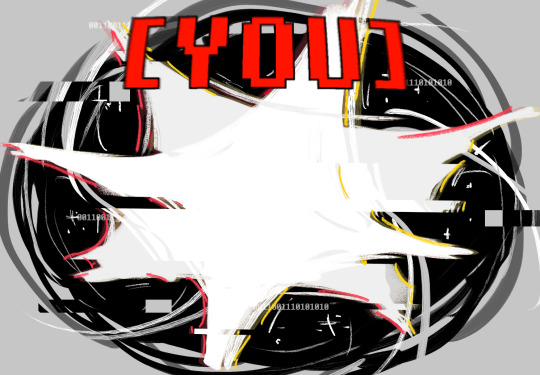

but if I'M a traumatized kid and YOU'RE a traumatized kid... who's playing the game!?
#frisk#chara#undertale#i just think the player as some kind of eldritch entity would be sooooo funny. the eldritch god capable of deleting everything#wants to smooch a ghost#also i'm not really a subscriber of 'demon chara' theory/canon#like thematically they DO represent the player or whatever#but also#.... they are just a silly kid :)#who likes chocolate :)#plart
14K notes
·
View notes
Text
usually i kind of hate when a piece of art feels indulgent sorry #earthmoon BUT i hate how often i hear the take that all description in writing needs to serve the Grand Unified Purpose of the work and you can tell its dumb because imagine watching an animated film and saying they shouldnt bother to put any detail in the backgrounds because its not important to the plot or theme 🤔 like it can be one stylistic approach especially in short fiction & can description and details feel pointless and unearned sure but the idea it should only rain if ur character is sad is goofy af and the idea that every element of the world should revolve around ur character and their narrative its giving western individualism
#also using narrative voice means u can MAKE any detail thematic based on how it's observed. skill issue#in fantasy especially idgaf about like. Hard worldbuilding#but I DO gaf about the vibe. and i want to feel like the world exists outside of the character#also think it's another case like the show don't tell of emotion where the issue is probably on a deeper level than prose#like say Piranesi the story is constructed such that all the description is part of the storytelling and feels meaningful bc the story feel#meaningful. in the same way that no matter how u describe the physical sensation of sadness#it will be meaningless unless the character has a good reason to be sad#anyway I read this interesting take a while ago about the very idea of story structure being like#an individual person is changed (which fixes things) is a very western (capitalist) way of defining a story#and honestly even in folklore as much as the players are individuals they're almost always archetypical and representative of a relationshi#on a mass scale e.g class/gender/parent to child#and the turning point represents - for example - disruption of & then reassertion of a social norm#rather than like. this is a Person and they become a better or worse version of themselves which transforms the entire Story World because#orbits them and stems from them in its entirety#anyway whatever. hi
8 notes
·
View notes
Text
why do dark souls end credits songs reach directly into my chest and pull my heart out
#misc.txt#the ending osts for ds1 and ds2 both make me feel some kind of way#and it's like they're not even 100% sad. theyre so achingly bittersweet. that's what gets me.#did you make the right choice? do you fully understand? will you ever?#and especially if you choose the ending that continues the cycle#your story is over and history repeats as it has done and will continue to do. over and over again but your story ends here#it feels cathartic in a way. but still sad. it feels almost representative of death which is fitting I think considering both#ds1+ds2's ending. you aren't 'dying' but you are burning forever to continue the cycle or being sealed in a throne room as it starts again#the snake eats its own tail once again etc. etc. for better or for worse#from the perspective of the player character - you DON'T know if it was for better or for worse. you just continued forward#like you've always done#bc at least in the case of a blind playthrough I feel like continuing the cycle is the most likely ending you're going to get#in ds1 I linked the flame because I didn't know you could just leave. I got that ending because I just didn't know what else to do#and yes I did that because I didn't. like. read enough wikis or whatever but thematically. in-universe#if you don't find kaathe you (most likely) continue the cycle because what else is there to do? what else is there to do.#and if you don't do aldia's quest it's the same#what else is there to do but light the flame and take the throne and hope it's better this time. even though it won't be#*hold the end credits theme in my hands* it's not that deep but what if it was
6 notes
·
View notes
Text
Nintendo-vember Level 2: Howard and Nester: How you are not supposed to pay tribute to a comic
Ahhhh, Nintendo Power. Published by Nintendo of America from 1988 till August of 2012, this magazine was part of the childhood of many Nintendo fans. A magazine that functioned as a gaming guide, advertisement for new games and just fun overall for people enthusiastic for Nintendo.
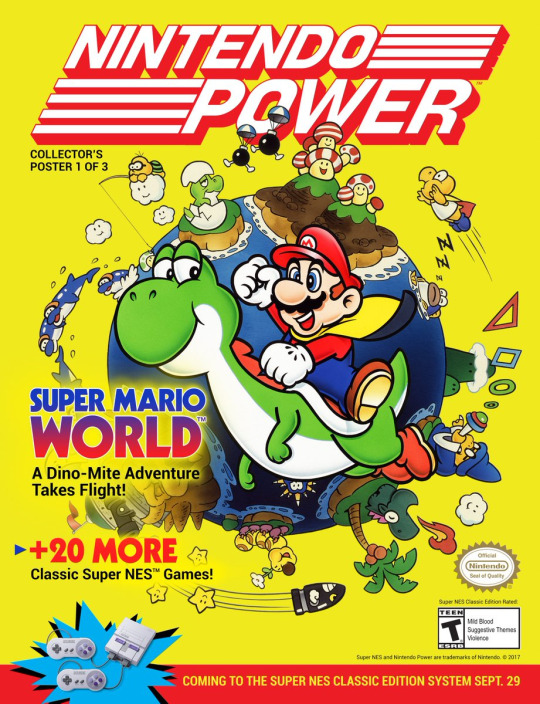
While we did not have Nintendo Power like that where I am from, we had a similar magazine called “Club Nintendo”, which ran from the 90s up till the early 2000s (2002 to be precise), after which it unfortunately got unceremoniously canceled. I had access to these issues thanks to relatives who enjoyed them a lot and honestly, I enjoyed them too. Very informative, highlighting many games and filled with some really fun comic stories here and there.
Now, Club Nintendo wasn’t entirely like Nintendo Power though. For example, among our comics in the magazine we did not have the subject of today’s post: Howard and Nester.

Now for those unaware who they are, a short explanation: Howard and Nester were the characters of a short series of comic strips from the very early days of Nintendo Power. Howard was an adult business man with a bow tie that Matt Smith may like, while Nester was a ten to eleven year old redhead NES player. In other words, he was a little shit.
Howard himself btw was based on Howard Phillips, initially a warehouse manager for Nintendo of America, who at a very young age (he was only in his 20s when he started working for Nintendo) joined the company and would play a major role in the marketing of the NES launch in America. He was also an avid videogamer of the “olden times” so to speak and was Nintendo of America’s spokesperson number uno. Liked by many within the industry, he did however eventually leave Nintendo in 1991 (at only 32 years old), to pursue careers in other companies. Which did not work out quite as well, according to Wikipedia. Though he is still hanging around, kicking, playing and working in the industry, for some german firm no one really knows about.
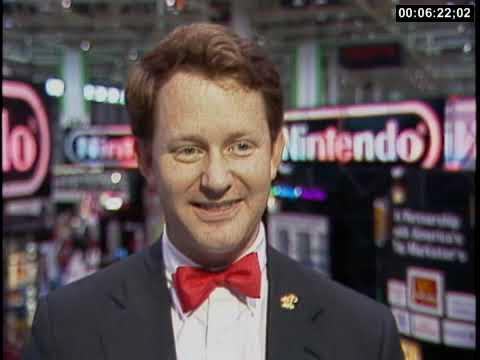
Man, he even looks kinda like the eleventh Doctor.
Anyway, back to the comic itself: The comic strips were essentially just meant as short, two page fillers ad would feature the caricature of Howard Phillips and Nester, the later supposed to represent Nintendo fanboys, finding themselves in environments related to a current videogame and dealing with whatever situation. Most of the time just ending in some comedic pratfall for a rather impatient Nester to suffer.

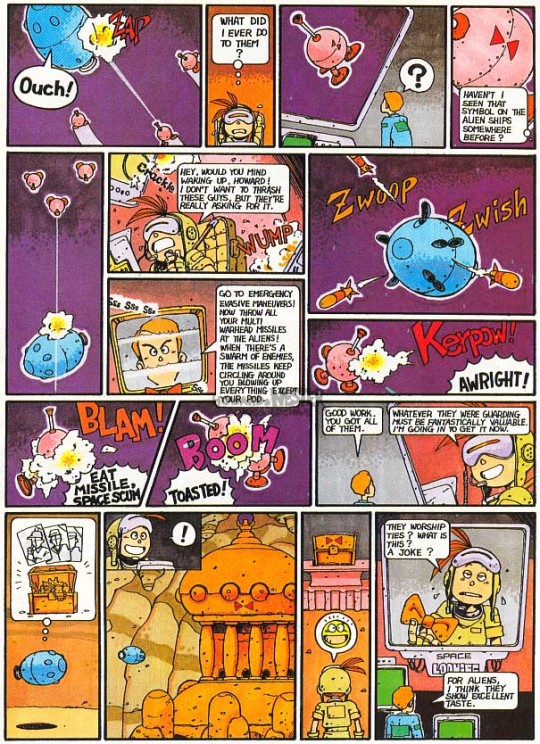
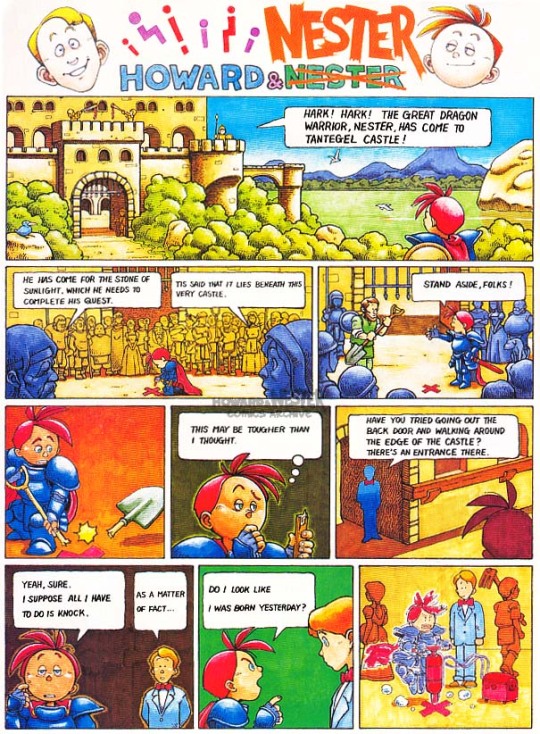
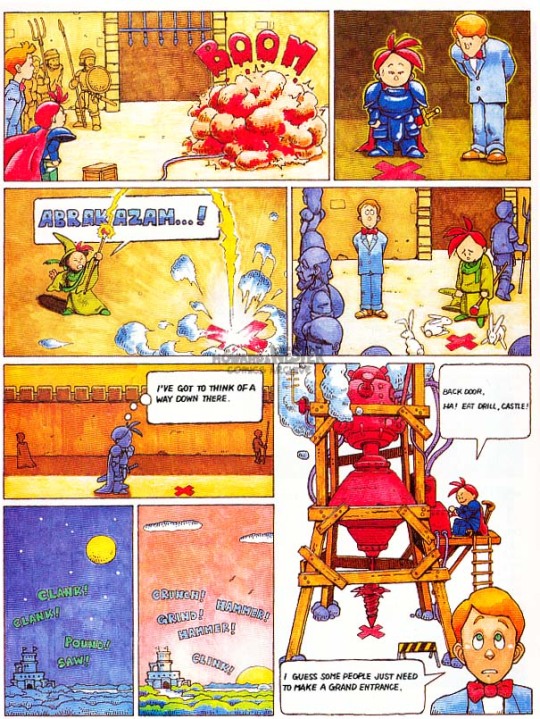
Then, after 25 strips, Howard, in relation to Howard Phillips leaving Nintendo, also left the comic, resulting in the thing ending and Nester going on some mini adventures on his own.


Now honestly, reading those strips I don’t think they are really bad. Howard as a character is rather supportive, there are small hints to games they thematically integrate in the comics here and there and some of the scenarios are kinda fun. Plus even the linework is okay for this sort of comic.
However, I genuinely think that Nester is a little bit of a shit. Especially in his first two strips.

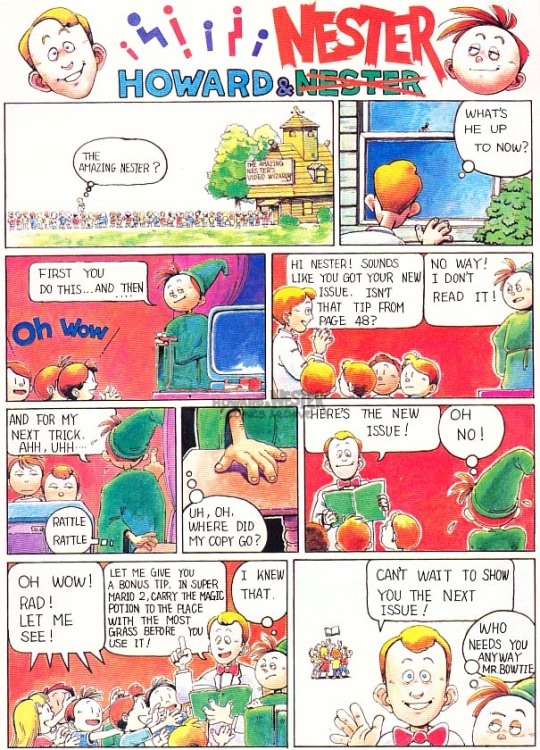
He just comes off as smug and a bit of a know it all. Believing he is better than Howard, not grateful for any advice and trying to come off like he is an expert in the eyes of younger, impressionable kids.
Oh god, he is Dobson!
Though that may be what adds to the pratfalls he suffers then. In addition, I am a bit baffled by what games they supposedly star in or how some of the games they talk about are executed in comic.
I mean, the Ducktales comic for example has nothing to do with Ducktales really aside of the moon duck enemy thing kinda being in it (though that may have been related to Disney telling them not to use Scrooge)…
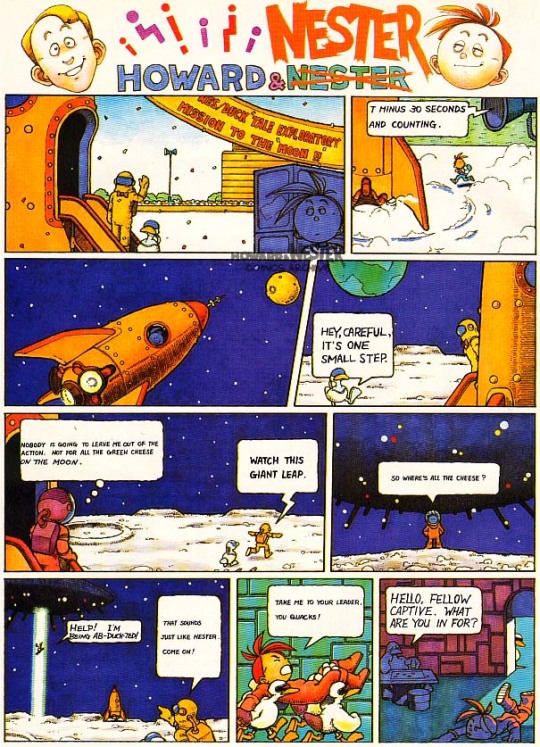

And then there is the fact, that a comic based on the Golgo 13 game was made.

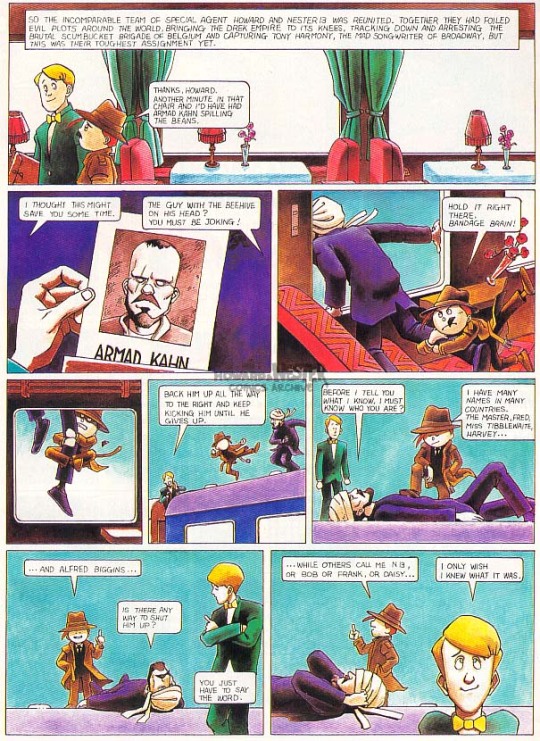
You know, THE Golgo 13? The game based on the famous manga about an assassin for hire?
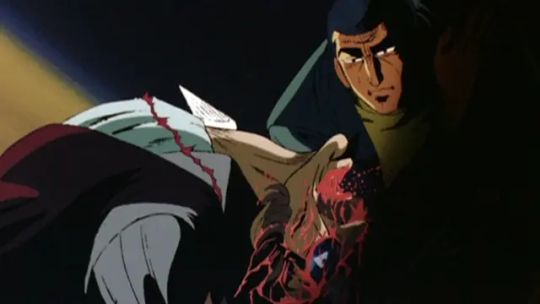
I mean, what next? A comic based on them in the setting of Home Sweet Home? Though that may have been cool.
It is just, I can see how the duo left some impression on early readers, but I can’t see how they could get quite the appeal, that back in 2008 Nintendo Power would release THIS comic, featuring a now adult Nester talking to his son about the good old days. A little manga-esque like tribute, some people enjoyed.

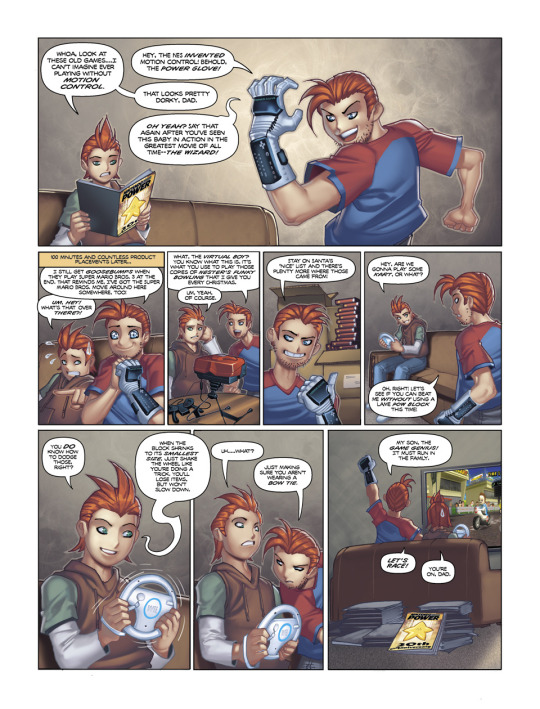
Not so much You know who though, who decided to draw instead THIS comic in order to “honor” the two and the style of the comic. And in doing so just ended up showing that he kinda never understood the character of Nester, nor the concept behind the original tribute in the first place.
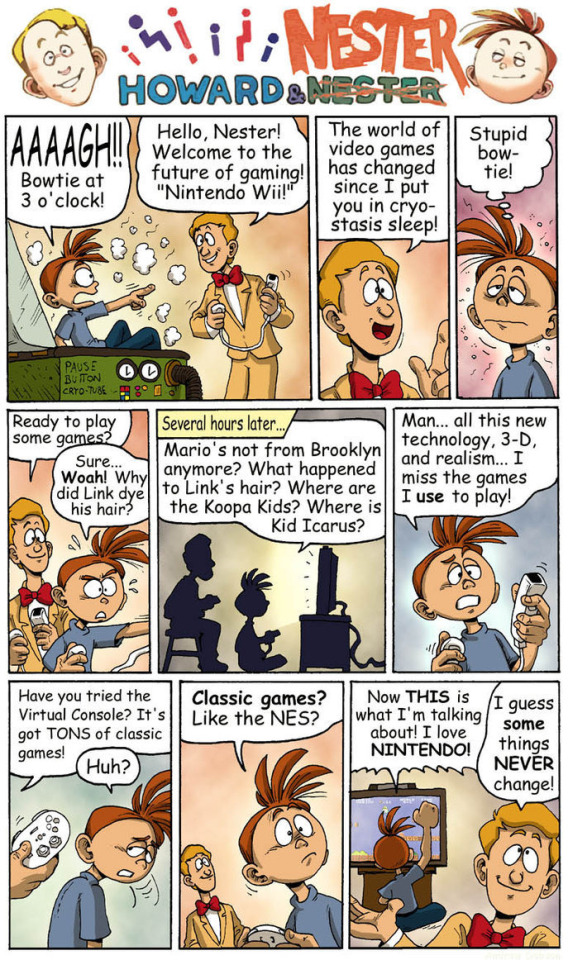
So, why does the comic suck? Because it is just an excuse for Dobson to project his own shitty opinion about how Nintendo “dishonored” the origins of the characters he claims to love onto Nester. All while making also both characters accidentally come off as losers and creepy. Particularly Howard comes off as horrible in the comic. After all, based on the set up established via the first two panels, I can only assume that the guy kidnapped a ten year old boy against his will and put him into cryostasis. Separating him from his family and friends, only to thaw him up again twenty years later. And for what? To show him how far games have come since then?

I get that the comic is supposed to be a joke (though I see nothing in it that makes me laugh), but… well..
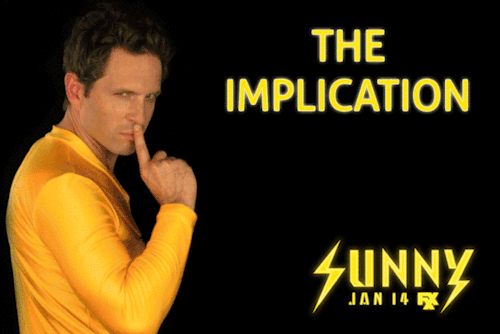
For that set up is rather unfortunate and feels more like it should be part of some existential horror story about someone finding themselves completely displaced in time and seeing, how their disappearance tore apart their loved ones. I for one rather ask myself, what happened to Nester’s parents? Were they accused of killing their son and send to prison? Did they commit suicide? Did Howard just kill them to get to Nester in the first place?
And the “motivation” to freeze him -I want to show you how games are played in the future- is just… that doesn’t even feel like a plan. I am genuinely at loss for words to explain the “logic” that Howard must have had and how none of that helps “the joke”.
Like look, the idea that Howard would e.g. pull out some magic item or machine to show Nester how in the future games are played and giving him a bit of a cultural shock only to return back to the present, feels like a set up that could have worked. But this is not the set up of this comic. This comic has Howard use an extreme measurement to achieve his goal, that comes just off as psychotic.
But hey, why bother elaborating on the ramifications of Howard having tortured a child like that (which feels like a great disservice to the real Howard Phillips), when there are games to play.
Or rather, complain about, because that is the only thing Nester does, starting from his shock at seeing Link now having blond hair.
Which is stupid as shit. I am sorry, but considering the kid had been on ice since the late 80s according to this comic, I think his first reaction to seeing game graphics from around 2008 would be “holy shit” as a result of a cultural shock. Not the fact that Link now has blond hair.
Also, way to prove how Nester is only a phony Nintendo fanboy, because he calls Pit by the name of Kid Icarus
See, little trivia bit here: The tendency of calling little Pit (btw, one of my favorite characters in the Nintendo canon ever since I played Uprising. I love that little shota) Kid Icarus, came mostly because of the awful Captain N: The Game Master cartoon from 1989, which named him by his game title. All while the game was a stable of the NES library since 1987 and Pit’s name was a stable in its freaking manual
Look for yourself: Page 7.
Also, getting riled up over Mario not being from Brooklyn when that was NEVER a point in the actual games anyway or Link’s hair color?
Hm, doesn’t that sound familiar…
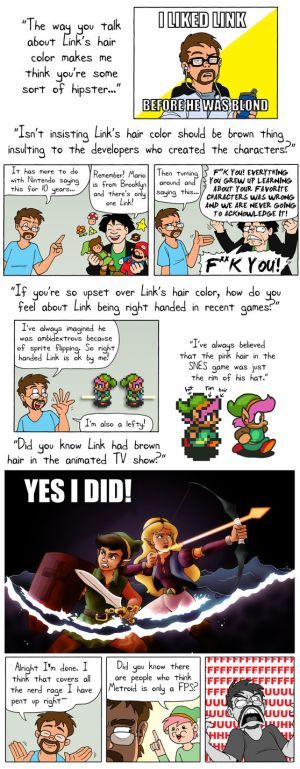
Look, I am not much a fan of Nester based on the strips I saw, but it would be obvious even to Helen Keller, that Nester here is not himself. He is a stand in for Dobson and his shitty opinions on how Nintendo “betrayed” the old NES fans by making Mario and Co more marketable and ignore their “true and honest” origins. The “real” Nester based on the strips comes off to me more like someone who would freaking geek out at seeing his favorite game characters being these detailed, cartoony badasses fighting equally great villains.
After all, playing as Link who can ride on a horse and fights a giant sized pig demon? Mario throwing planets at Bowser? Mario and Link duking it out with other heroes? Seeing Pit and Palutena in Smash Bros Brawl? Which btw came out in January of 2008, so Nester complaining about not seeing Pit- oh I am sorry “Kid Icarus” would be inaccurate too.
The point I am trying to make is, that if you grew up with the bare minimum presentation some NES games had, you would be gushing over anything “modern”
Heck, considering the sort of stuff Nester played or was into in the comics, he would likely drop the Wii once he learnt about stuff like God of War, Ratchet and Clank and other “badass” and “cool” games other consoles can offer.
But no. Nester is simply overwhelmed with the concept of 3D and “realism”. Though lets be real here, I think realism in videogames is an oxymoron, independent of what console we talk about. I mean, what is e.g. “realistic” about Mario, Sonic, God of War, Final Fantasy, Resident Evil etc? I know at least half a class of biologists who cry each time a new Resident Evil scientist comes off with a new variant of the virus.
Anyway, he is so overwhelmed, he simply just wants to go back to the old days and the game he used (or rather “use”. Btw, great job at even failing at simple past tense) to play.
Only loving the Nintendo Wii once Nester tells him about the online shop and that he can play on it the same shlock he already likely has memorized before Howard put him into cryostasis and as such deprived him of a proper childhood.
Meaning that Howards “plan” to show Nester the future of gaming failed, because instead of embracing the new while also loving the old, he simply rejects the former and embraces the later even more tightly, putting it on a pedestal the same way Dobson does.
Which frankly, is one of the aspects I find the most annoying about Dobson in general when it comes to Nintendo. I get it. He grew up with the NES and I admit, the console had some really great games that build the corner stones of many franchises and the Nintendo empire.
But, and you can crucify me for saying that, by modern day standards (or heck, even standards set up by the follow up console, the SNES) the NES era was kinda bad and many games, even a lot of the classics, can’t stand the test of time as much anymore than they once did.

Before you burn me on the stake, let me explain: I myself grew up with the SNES and GameBoy as my first consoles, so I never played the NES games, even though I was aware of them through Club Nintendo. Only in recent years, thanks to the NES mini and some game collections I downloaded on the PS4, I got to play some of the classic games. And frankly, I think a lot of them suck in some regard. Like the technical limitations of the time, the at times unfair programming to make certain games extra hard and how quick you can actually get through the game once you know what to do, make some games a bit of an underwhelming experience.
Granted, unlike Dobson I will admit, that my opinion is very biased. Coming from my own love of the SNES, as well as decades of playing other games too, including sequels to many of these starter games that managed to polish up things in term of gameplay and presentation. And there is no denying, that there have still been many great games on the console by Nintendo itself, but also third party publishers such as Capcom, Squaresoft, Enix or Konami.
Kirby, Mario Bros 3, Megaman 3 up to 6, Ducktales, Castlevania 3, Contra, Final Fantasy, Dragon Quest and Earthbound are at least some titles that come to my mind.
But it was also the console that gave us stuff like the LJN published videogames, got a shit ton of unnecessary equipment like the Power Glove, established the term “Nintendo Hard” and frankly, I find myself unable to genuinely play the NES Zelda games or Kid Icarus without feeling them quite underwhelming and a bit flawed. So bottom line, I think it was important, I think good stuff came out of it, but it was only the first steps into the right direction. The NES learnt how to walk, so the Switch could run.
Dobson meanwhile worships the era like it was the greatest thing ever, never topped and shoves his opinion into Nester’s mouth. Resulting in the strip’s entire message boiling down essentially to the following:
The past was greater than what we have now and is the only thing I love. Oh, and fuck you for making me try new things.
Which is ironic, coming from the person who among other things would claim that such a behavior is toxic years later. Going onto rants how Kylo Ren is such a nostalgic nerd and criticism of “toxic fans” when he ranted about Star Wars – The Last Jedi and that critics of it are all Nazis. Even though Kylo is the one saying “let the past die”.
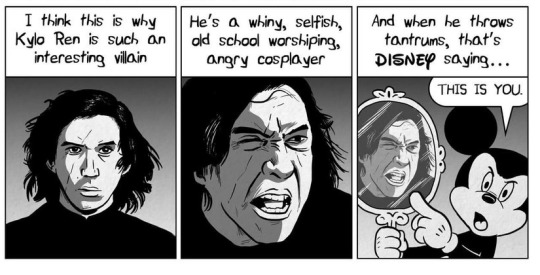
youtube
There is also just the fact, that the comic obviously misses the idea behind the original Howard and Nester tribute comic from Nintendo Power.
Like sure, the comic in the magazine was flawed. The manga inspired art work wasn’t that great and Nester felt like he grew up into the sort of young adult who made videos on youtube in the late 2008s, trying to emulate the AVGN by reviewing old NES games and acting like he is hardcore for enjoying “The Wizard”. All while being in reality more of a dork, especially in the eyes of a son that actually comes off as way older than he likely should be if Nester is only in his late twenties or early thirties.
But I think that was kind of the point. Making Nester more a caricature of the “gaming nerd” of the time period, while also indirectly playing a decent tribute to the old days and showing Nester having gotten older, though not necessarily wiser. But considering his kid seems to be doing okay, I doubt he is that terrible of a dad.
Which begs the question though, what is it about the comic that pissed Dobson off that much? The “manga” style? Granted, I think they could have gone more with a style akin to what the original comics had, which is the only thing Dobson has going for his page, that I can actually appreciate. But it could have been worse.
Is it the idea of Nester actually changing as a person, growing up? I mean, considering how allergic Dobson was often times to the idea of change (except when it was related to dumb reboots that may piss off republican strawmen in his head), I could actually believe that.
But if that was what pissed him off and his idea was to make a comic doing a tribute to these two the “right way”, Dobson failed miserably. Because all he did was make Howard come off like a psychopath for freezing up a kid to show him some games and Nester like a moron who can’t appreciate positive change in the media he consumes. All because Dobson was rather focused to vent his own frustration about Nintendo through their mouths, rather than respectfully draw a story with them. Something he even admitted
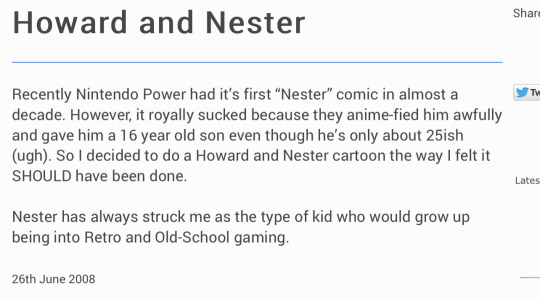

The artwork may be decent here, but the writing is a failed assignment.
The most ridiculous thing about that being, that either some time later or before, Dobson made a way better comic starring NEster, that actually gets the vibe of the original
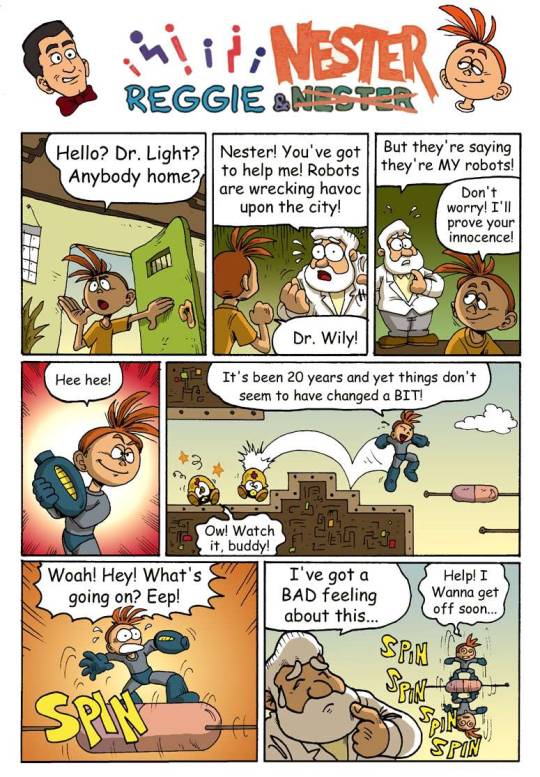
And before someone claims I can only complain and not bring some alternative to the table how to execute the comic, here is what I may have done:
Start the comic as Howard and Nester in the Back to The Future NES game, supposedly having just finished it. Only for Nester to end up playing with the controls of the DeLorean and in doing so transporting him and Howard into the future. Materializing in 2008, they then learn about the actual positive things happening to videogames ever since , though Howard may also learn to some degree about the bad stuff whe he reads up an article titled “Rise and Fall of videogames” or something related to Jack Thompson). Have Nester for example geek out about Smash Bros, question what a Pikachu is, hitting himself in the head accidentally with a Wii Remote, but overall try to also give a positive message to it all.
Like Nester befriending bunch of kids via Wii playing. The comic then ending with the two travelling back to 1988, Nester all pumped up about the prospect how great videogames will turn out in the future -perhaps also being a bit impatient at the prospect to wait 20 years to play Smash Bros Brawl again- while Howard muses about the things yet to come. The final panel perhaps being set in 2008 with an older Nester looking over a little brother who befriended by accident his younger self, challenging the younger one to a rematch he had “lost” in the past.
I know, sounds corny as fuck, but it at least would nullify the entire “I kidnapped you and froze you up” implications of the original comic by Dobson.
Now, unlike Dobson, I do not intend to leave a bitter taste in the mouth of the readers, so I want to end this post on a sweeter note by informing you about the following:
When Nintendo Power eventually ended on issue 285 in December of 2012, someone at the editorial team must have remembered Howard and Nester, because they decided to have this little two page comic in it.
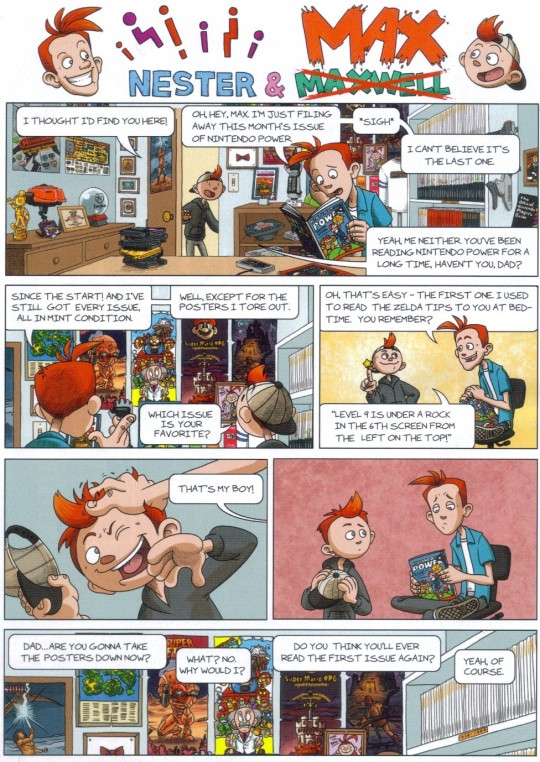

Nester, drawn in the classic style, as a way more well adjusted adult than in the 2008 comic, reminiscing about the magazine that he owes his existence and had brought him many hours of joy. His son helping him accept that it may be over for the magazine, but that the enjoyment will never 100% go away. Even adding a little framed bow tie in the background of the last panel, symbolizing that in hindsight Nester likely came to appreciate Howard as more than just an annoying mentor sort of figure. All before heading out to play a new Mario game with his son. Leaving the past behind but close, while embracing the future.
A comic, that in my opinion hits on the sweet “bittersweet” spot of such things as Fullmetal Alchemist or Amphibia. Giving the “story” a proper wrap up and assuring people that it is over, but that the characters themselves in a way are -unlike Dobbear- never gone.
And if you want to read all the strips of Howard and NEster, here is a link to the archive I found for this post.
Level 2 is done. Time for some bonus round and then the next level soon. Cause now we are really going deep into his whinning over the superiority of the old Nintendo canon
#nintendo#howard and nester#nintendo-vember#andrew dobson#tom preston#video games#nes#comic#webcomics#so you are a cartoonist#syac#so you are andrew dobson#howard & nester#nintendo power#youtube#Youtube
28 notes
·
View notes
Text
So. Out of curiosity, given recent events, I was looking at Pathfinder 2e, just to see what it felt like. And, being me, I decided to do this by seeing how easy/difficult it would be to port my homebrew deities over to it. And the results were … interesting.
In that it is not necessarily easy to port deities over, but for a rather cool reason and in a cool way. Apparently, if I am understanding things correctly, your deity is functionally your subclass as a cleric in PF2e? As in, you get a couple of spells from your domain, sure, but you get more spells, an ability increase, a skill, a weapon, and your Divine Font all from your deity. You also need to match your deity to your alignment, and your deity gives you edicts to try and follow and anathemas to avoid if you don’t want to face consequences. Your deity is, essentially, your subclass.
(I’m not ignoring doctrines, I’m just mentally thinking of them more like warlock pact boons? Actually, PF2e clerics are reminding me of 5e warlocks in a couple of ways, really)
It's actually … Honestly, I find that really cool? From a worldbuilding perspective. Now, I can see from a player POV how it might feel quite restrictive, particularly the alignment, edicts and anathemas, but from a story-expressed-in-mechanics POV … It always slightly bugs me in DnD5e that clerics of completely different gods who happen to share a domain will be mechanically identical. You can have, for a random example, a Trickery cleric of Asmodeus and a trickery cleric of Garl Glittergold, and they’ll play the exact same way (mechanically, not counting RP). Your deity, to an extent, is kind of a cosmetic choice beyond domain. But in Pathfinder, your deity is distinctly more crunchy and involved, and I do kinda love it.
It does make porting homebrew deities from DnD5e to PF2e a bit more involved. I am going to work on it, just to see what it’s like, but already I’m having to think about a lot more than the alignment and domains of 5e. Though that is … in one sense it’s fun as a worldbuilder, because a lot more of the deity’s ideals and values and pet peeves are represented mechanically. It’s cool. Working out their domains, their edicts, their anathemas, their boons, their abilities/skill, their spells …
As an extension of this, can I say, there’s some really gnarly spells in PF2e. I’ve no idea if they’re good or not, but for ideas alone there’s some spectacular stuff. For Nalashtar, the plague goddess, for example, I was browsing both Blister and Grisly Growths as potential options (I think Grisly Growths might be the one). Absolutely disgusting, but thematically amazing.
The only downside is, again if I’m reading this correctly, the spells given to deities need to not be on the divine spell list, because deity spells don’t work like DnD5e domain spells, where clerics get them as extra prepared spells a day, and instead are more like warlock patron spells, where they’re options that the cleric can prepare, but they don’t get them always prepared for free. So if a deity’s spell is on the divine spell list, it functionally gives the cleric absolutely nothing extra, since they already had that spell as an option to prepare.
This is a bummer, just from a thematic standpoint, because I read the spell Quick Sort and instantly wanted to give it to Alatee. Is it useful? Not a clue. But it’s bang on for theme. And, yes, she has it anyway, in the general sense that her clerics can use it, but it would have been so good to have it front and centre in her bio to remind people. Oh well. If I make a cleric of Alatee, I’ll know it’s there.
This is definitely turning out to be an interesting exercise, whatever else. Heh.
(Sidenote: I’m getting my PF2e info from the Archives of Nethys site)
#d&d#pathfinder#homebrew#deities#homebrew deities#converting dnd5e to pf2e#it's definitely interesting!#pf2e
99 notes
·
View notes
Text
every so often i come across videos talking about pokemon and discussing how mainline pokemon games always have lackluster plots and like. here’s the thing on one hand pokemon mainline game plots always do tend to be super simple compared to other series and even other spinoffs within the same franchise (like pmd). but on the other hand i feel like its incredibly dismissive of what does exist (and obviously I’m the fool for watching youtube videos on subjects i definitely know more about than them) and also feels like they miss the point on what kind of stories these games want to tell.
but then I really sat down and thought about it. what DOES make a good pokemon plot for the mainline games? because they are formulaic, you always repeat the same process and hit the same plot beats throughout, much of what changes between games is just the creatures and the aesthetic along with whatever new gimmick they might introduce, but overall you can play one pokemon game and you’ve basically played them all so what changes? what really separates pokemon games from each other? what makes people love the world of pokemon so much aside from the creatures?
and then it hit me. pokemon mainline games always have simplistic plot, but a phenomenal narrative. The plot is the story that’s trying to be told, but the narrative is the presentation, the thematic core within a story. The thing about pokemon is that the plot is supplemental to the narrative, rather than the narrative being an aspect of the plot like in most stories.
True, in every mainline game you basically do the same cycle of getting your starter following the map beating the gyms stopping the evil team leader and becoming the champion. But the thing about pokemon is that the actual plot is secondary to the intended purpose of having you actually explore the world. You’re not MEANT to care about the plot details, but rather the plot is flavoring to the characters and world building.
Think of the Gen5 games for a second. People often consider these the best written pokemon games (and for good reason) but what I always notice is that people never bring up the central plot as a reason for that. Rather, the big draw of the writing is the character writing and lore: the circumstances surrounding N, the thematics of what Team Plasma represents, the Memory Link side stories. All of these you can entirely ignore in any given playthrough of a bw/2 game (you can even 100% the games without touching any of these!), yet they’re the things that stick out the most to players for years after the fact.
The same is true of every pokemon game, you don’t care about the central plot, but rather the world and the characters where the majority of the writing IS focused on: Silver’s struggle with his father, Maxie and Archie as well-intentioned villains, Cyrus as a character who wants to save the world from itself, you can ask any pokemon fan to talk about their favorite characters and even though the plots of the games are incredibly simple, they can tell you tons of things about the characters.
That’s something of a trend I feel exists in Nintendo’s biggest games: there is no plot, but you care about the world regardless. Mario games don’t have a plot but we enjoy playing through the worlds. Legend of Zelda recycles its plot basically every game but you remember the interesting dungeons, the funny and weird npcs, the actual experience of discovering the world and its lore. Kirby has no plot whatsoever but uses its aesthetic and presentation to build a world and a lore out of it, putting the focus of exploring the world to the player by giving you a mechanic that lets you skip the game entirely. Pokemon does largely the same thing with its games, but since it’s an rpg there has to be SOME writing to it, and they always attribute that to the characters. Quite literally, its about the journey, not the destination. This is particularly why I kind of love the Gen7 games, because while I do absolutely agree that the game drowned you in cutscenes, the most memorable things about it to me were the random little events you could find around the region that added so much personality, not to mention that this time the plot was driven specifically BECAUSE of the characters narrative (Lillie) rather than having it as a consequence of there needing to be a plot. This is also what I feel Gen6 failed with, because as much as I loved Kalos as a child, they focused far too hard in trying to Have A Plot that they ignored the narrative entirely: you don’t really care about Lysandre because hes never really shown to make any kind of sense, and Kalos as a region was ultimately empty. The one interesting character in XY (AZ) is tied directly to the lore they do introduce, which is his main draw as a whole, but outside of that there’s very little to it all.
This is also why i feel that pokemon spinoff games have such banger iconic stories to them as a result? because the mainline games have a very simple plot but have incredible lore, world building and narrative to them, so when a spinoff actually takes the time to add a properly written story to them its always incredibly complementary as a result and basically half of the work in writing a story is already done, so they can focus on the characters entirely. Anyone whose ever played a mystery dungeon or ranger or any of the other story based spinoff games can tell you that their stories are always incredible.
If they ever do want to make a pokemon game with a legitimate plot to it, I don’t even think they’d have to revamp the formula and gameplay loop that all games have you do, but rather add some extra importance to it. They somewhat tried to do this with HMs I feel, where you can’t progress in the world unless you beat the gyms, but instead of having the gym challenge just be something that the player is pushed into, actually making it a core defining aspect of whatever hypothetical story the writers would want to tell. They could even toss the gym challenge out entirely and try something new, but overall in order to have a good plot, they’d need to make the progression within the game have some type of importance aside from letting you advance in the world.
105 notes
·
View notes
Note
♦️🗡️🏁🌹 for étoile!
Thank you for the ask! And for coming up with This Ask Game, it's been a lot of fun!
♦️: Are there any motifs you associate with them? What do those motifs represent thematically?
Answered here.
🗡️: What type of weapon do they normally use? Is there a particular reason for it?
A one-handed weapon and a shield. Sword and board! As they say. Their mother taught them, who was also a paladin. I like playing tanks in single-player games. I worry about playing tanks in multiple-player games, don't want to let people down. Étoile used maces far more often than swords in b/g3 but that was more by coincidence than by design. Whatever will hit the enemy hardest.
Étoile's fighting style is Protection (When a creature you can see attacks a target other than you that is within 5 feet of you, you can use your reaction to impose disadvantage on the attack roll. You must be wielding a shield.) and they picked up the Feat Shield Master at level 12. They're very oriented to prioritize the safety of squishier party members. They like protecting people.
🏁: What do they consider to be their main goal in life, the thing that motivates most of their actions?
Étoile didn't have a specific life goal before the events of b/g3. They wanted to join a Paladin order because their mother was a Paladin who protected people she cared about, and they idolized her and that lifestyle. They always presumed that one day they would return home to Auril's temple, stronger, smarter, having spread tidings and the wrath of winter both. A worthier person to inherit the duties of her holy place. This feels less and less likely to them all the time.
🌹: Are they experienced romantically? How many romantic partners have they had? How has this affected their view of romance?
They are experienced romantically. With flings and affairs and with little dedicated romances that last a year or seven, though their previous relationships haven't felt like investments or partnerships. Étoile had always wanted to be a romantic but haven't felt driven to romance / comfortable with those sorts of declarations until Astarion specifically, and Astarion has kind of helped open that door for this behaviour to be a possibility with other partners. Étoile has had 17 romantic partners before the events of b/g3. One while they still lived with their mother and sixteen in the thirty years they've been based out of Baldur's Gate. I don't think their number of partners has affected their view of romance? Maybe the nature of them (largely casual?) or the types of relationships (often open in general or other forms of non-monogamy). They would think their views on romance are healthy and fluid.
8 notes
·
View notes
Text
Outside Influence: A Roleplaying Board Game about Manipulating Mortals' Fates

https://lackoftrumpets.itch.io/outside-influence
Outside Influence has to be one of most experimental games yet! The game takes place in the world of Pytha, a slanted world that is constantly in conflict. Because of the large amounts of wars that are waged, creatures called "forces" have taken an interest in the struggles of Pytha's people. These forces play with mortal lives almost as if they are pieces on a chess board. Some forces wish for an end to the constant wars, to make sure the conflicts continue, or for their two favorite mortals to fall in love. Every force has their own desire, but they will do whatever they can to make sure it becomes a reality.
Just like how the forces of the world view the conflict, this game is played with an actual chessboard. The major players in the conflict are all represented by pieces on the board. Every player has the ability to move any piece, changing how that character's story might unfold. The game is meant to be played without a GM, so players will end up sharing roleplay duties at the table.
Unlike other board games, Outside Influence has no set win condition. At the start of the game, players choose what they believe their force's ideal goal would be. This game is designed to be a roleplay sandbox where players can roleplay as many different characters in a wide variety of locations. All while manipulating the fates of other mortals.
This game was designed for @officialguild66 (or SighTdesigns) Narrative Design Jam. I wanted to make a game that extended beyond the normal boundary of a narrative TTRPG and I think I mostly succeeded at that. Having the chessboard be the game space I think was a good thematic decision for it. The game jam was made to embrace all types of narrative games, so there is more than just narratives TTRPG. I recommend you check out all the other great games people have made!
11 notes
·
View notes
Note
why do you think navi left? i’m still confused…
i am once again going to plug my loz analysis doc because i do go into navi's disappearance briefly in both the oot & mm sections but tldr i do not know and it has driven me insane for the last seven years of my life.
navi to me is representative of a support system to link in oot. when link has no one else on his side, when no adult will listen or guide him, navi is there throughout EVERYTHING. she is imperative to link's ability to fight both narratively and as a game mechanic--she is tied to the targeting mechanic. when you briefly lose her in the final battle it's a genuine handicap, because link is unable to target and therefore unable to fight when he is completely alone, and all your energy is focused on removing the block on her so that you can target ganon's weak point and win the final battle. link CANNOT win ocarina of time without navi. which is why it is SO difficult for me to rationalize her unexplained absence in the game's otherwise completely cohesive direct sequel. a fairly popular theory (at least back when i was 12 and frantically googling "where is navi majora's mask") is that, since link has completed his purpose in regards to the hero's destiny by the end of oot, navi was "no longer needed" and therefore left him. I don't like this theory for several reasons, the most prominent being that i resent the idea that navi was nothing but a guide given to link due to his possession of the hero's soul or whatever. navi was a FRIEND and a SUPPORT SYSTEM to a deeply traumatized, manipulated child who quite literally had no one else in the world on his side. and there's a lot of that echoed in majora's mask, especially the first day--you're alone, you're helpless and without a weapon, you're confined to clock town and treated as an inconvenient child by everyone you talk to. you have a fairy companion, yes, and she fills the gap somewhat, but tatl and tael always felt much more like children themselves than adult guides and supports the way navi did. tatl just doesnt quite have enough figured out herself to be as supportive to link in that situation as navi might have been. and in some ways this serves majora's mask quite well--it reminds the player of the "terrible fate" they've met with and lends to the weird atmosphere of clock town. it's a subtle signal that something is REALLY wrong.--the fairy, established in previous games as a species that served to guide you and tell you what to do, isn't quite sure what's going on either. but they had to retcon navi out of the story to get that effect. practically, thematically for majora's mask, a character like tatl works better than a character like navi, but it leaves a plot hole that demands explanation. all that being said, the only way I PERSONALLY am able to rationalize such an abrupt disappearance by navi is to say that something came up that she needed to deal with, but which was on the same or similar level as ganon, and navi, being the only adult in link's life who gave a shit about him, didn't want to subject the poor kid to anything else like that and so left him (hopefully temporarily) to deal with it alone, like any fucking responsible adult should (instead of idk putting a 9 year old to sleep for 7 years and then expecting him to be fine and willing to fight monsters the second he woke up.) there are holes in this interpretation, obviously, such as what the hell navi is dealing with and why, and why link had to set out to search for her at all if she told him what was going on, but canon gives us literally nothing so smaller plot holes are better than huge ones.
#WOW. AHAHA. THIS MIGHT BE MY LONGEST ONE TO DATE#sorry but you can't ask me anything about oot or mm without getting an essay in response and ESPECIALLY not about navi#asks#zelda analysis
91 notes
·
View notes
Text
American Extraplanars
CW: A European slagging off America
I've been thinking about accents. They're a great way to convey cultural differences across different parts of my world, and I draw from real world accents to signify the cultural background of characters when I'm playing and DMing.
In my world, most of the countries thus far established are heavily based on real ones. Graddeland is England, and Rama is France, Ralskyov is Russia, Hjelvord is Sweden, et cetera. But I ran into a slight problem of what to do with the USA.
See, a North America analogue exists in my world, but it's inhabited primarily by the Crelkowaa, analagous to the (diverse, continent-spanning cultures) of Native Americans. My 'Europeans' haven't invaded and made them a minority, for reasons I'm still working on, but the idea of Native American analogues being major players in my world is something I'm really keen on.
Of course, giving the Crelkowaa American accents would be immensely disrespectful to their real inspirations. But American accents also represent a wealth of opportunity and personality. Then it hit me - why not give American accents to fiends, or celestials, or both?
Especially with celestials, since in my world I like to think of celestials as ill-informed arrogant busybodies that like to police the world according to whatever god is commanding them, and may see themselves as its saviours, but they often make things worse with collateral damage or unintended consequences (or for some gods, entirely intended and selfish consequences), and most mortals would really rather they fucked off. A cheeky thematic link between 'divine intervention' and American foreign policy? That would be fun!
It could work well with fiends too. I especially like the idea of portraying devils like overly friendly east-coast fast-talking salesmen, trying to convince you that whatever they're offering is worth your soul. Think Alastor from Hazbin Hotel.
I also recognise that the American accent is derivative of what the English accent was at the time America was being colonised, but I absolutely refuse to ruin the analogue of my own country by making them talk like Americans!
Besides, I think most of the pressure I felt to give Americans somewhere to be in my world really just comes from the overwhelming dominance of American media and their superpowered role in the current geopolitical ecosystem. In the grand scheme of things, the USA is still a very young country, established by a genocidal invasion from another continent, with very little cultural identity of its own, and certainly none that's very old. I don't think it provides much to inspire fantasy worldbuilding, at least by my own methods and vision.
The continent of North America, though? Incredible landscapes! iconic wildlife! And from a European perspective, riddled with mystery and discovery. This combined with native cultures creates a gold mine of inspiration for monsters and magic. Paradoxically, while the USA doesn't make for particularly good fantasy, the continent of North America does, and its potential is largely wasted.
#Not to imply that Britain hasn't also made horrendous foreign policy decisions and making them token bad guys isn't 100% reasonable#But the difference is England is a REAL country#Not a country where half the population insists they're Irish#or German#or Italian#Or indeed English
2 notes
·
View notes
Text
Entropy Effect coverage; Pt. I
A day into playing the game, reviews of the game are skill expressing a lot of doubt as to whether or not Entropy Effect was ever meant to be a BlazBlue game in the first place. I'm still wondering if the BB IP was slapped on due to executive meddling and media company's modern trend towards an extreme reluctance to release new IPs.
As I understand it at this time, Entropy Effect's story is unrelated to BlazBlue's. However, as I said in a previous post, I do see how the two narratives are thematically compatible. Ultimately I'm not sure how long I'll be covering Entropy Effect, as I don't entirely consider it a BlazBlue game, but for now I'm committed enough to uncovering its secrets.
So, let's take a look at the story so far!

The SkysEyes entity that I read as godlike from the trailers seems to be some sort of company. It may be what manufactures all of the robots and runs the city in humanity's absence, judging by the SKYSEYES decal printed onto the bodies of several of the robots we meet. When the protagonist asks an NPC if they "believe in SkysEyes" in the trailer, they were likely asking if the NPC trusted their mysterious overlords, as even just a half hour into the game, they're already starting to look a little suspicious.
But speaking of the city SkysEyes seems to run, I'd theorized before that the stages were we battle and play as BB characters were likely simulations- but it seems that the entire setting is one. Characters within the story refer to it as "a virtual world."

Also something I discussed in my pre-release coverage, the character we play as is called ACER. As I thought, this isn't a name, but a term used to describe "those who participate in the ACE Mind Training program." The 'ACE Mind Training program' is the in-universe term for the roguelite gameplay; it's the little battle simulations we do as the BB cast.
Though this seems to be a well known part of the setting's reality, at the start of the game our player character (our ACER) responds as if they've never been called by that term before.

They react to every new concept of Mind Training as if they're extremely new to the idea, and they're surprised (or doubtful, depending on the response selected by the player) to hear that they have a particular talent for it.
Some hints are starting to emerge that this isn't their first time going through all this, though. When we talk to an entity on the second floor (that another character very suspiciously insists doesn't exist) they greet us as if they already know us- while the protagonist seems entirely confused.
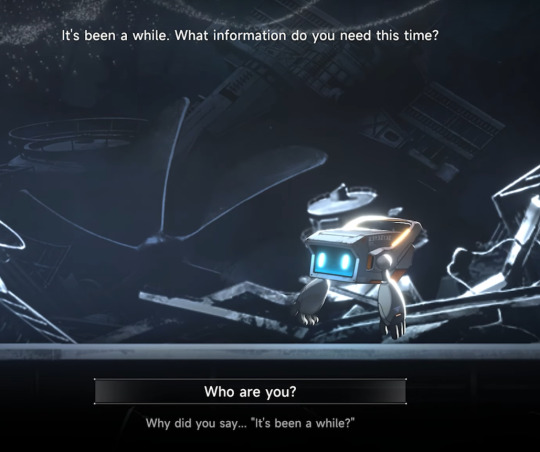
We also see this ridiculously high counter during our interaction with them. It looks like the counter we've seen ticking up in trailers for the game.

It's all very strange. Unfortunately, I don't have any more information on it at this time, so let's move on to something else; the gameplay loop, and its purpose in the story.
We know what Mind Training is, sort of, but why are we, the character, doing it? Our ACER seems to hint at a rumor that "Mind Training can help [someone] resist Entropy Particles," a substance that corrupts one's mind. With what little we know about them this early into the game, they remind me a little bit of the psychological effects of Seithr poisoning. Look at Roy's descent into madness. But that's just a theory- where I am now, I have yet to actually see anyone 'corrupted by Entropy Particles.' The connection may not have even come to my mind if this game didn't carry the BlazBlue title.
As for the idea that the Mind Training simulations prevent whatever cruel fate is brought on by Entropy Particles, our guide (a representative of the ACE program) expresses that this theory isn't perfect. It isn't a guaranteed cure or defense against the corruption, but it's currently the only treatment that has been found to work at all.
The fact that the protagonist asks about this, and is participating in the Training in the first place, makes me think that they are already suffering from this mysterious condition. Is everyone in this virtual world 'sick' with it, or only a select few? How does it spread? Is this something that only affects robotic/simulated creatures, like our cast, or is it affecting people in the material world so as to necessitate the creation of this entire simulation to treat it?
Right now, I've got no idea. I do wonder, though, if this could explain the discrepancies between the protagonist acting as if this is all brand new to them vs the setting hinting at the fact that we've done all this many times before. Do Entropy Particles interfere with memory?
4 notes
·
View notes
Text

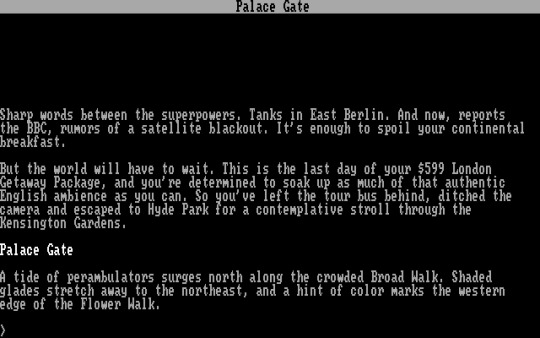
Trinity (PC)
Developed/Published by: Infocom
Released: 9/5/1986
Completed: 18/08/2023
Completion: Finished it. 100/100.
Trophies / Achievements: n/a
Oppenheimer fever has long subsided by the time you’re reading this, and to be fair, had subsided by the time I finally booted up Trinity, but it was seeing Christopher Nolan’s surprisingly human film in 70mm IMAX that led to me skipping forward a few months in 1986 to play this, Infocom and Brian Moriarty’s attempt to grapple with the history of the atomic bomb from the context of the ongoing cold war (although by 1986 it was beginning to thaw, with Mikhail Gorbachev in power and Reagan already three years out from having his mind significantly changed by a screening of The Day After.)
Trinity in many ways is a companion to Steve Meretzky’s A Mind Forever Voyaging, in that it accepts that all art is political and is trying to be something deeper than even Infocom have attempted. But it also stands in contrast to it: A Mind Forever Voyaging is essentially puzzle-less and “realistic” whereas Trinity is absolutely an adventure game, packed with puzzles and fantasy locations.
Both games have their proponents and detractors (The Digital Antiquarian, interestingly, is a Trinity man) but I’ll be honest: for me, there’s probably a middle-ground that I’d like a bit more. Because Trinity falls into the major problem that I always seem to have with Infocom games: you don’t know what to do, or why you would do it.
It is, absolutely, the fact that I’m playing these in my spare time in 2023 rather than, you know, having put down the equivalent of $100 or whatever in 1986 to get a box with a lot of fun stuff in it, but I often wonder: did Infocom’s “Imps” simply believe players can and should work out what they’re supposed to be doing by repeated playthroughs, trial and error, failure, or was it the kind of thing that simply never occurred to them?
I supposed I’m being slightly unfair to Trinity. The game, after all, does begin with a simple vignette (you’re on holiday in London, trying to enjoy a day in Kensington Gardens before a nuke gets dropped on you/it–though you don’t know that yet) where you will quickly be driven to chase a roadrunner because… well, I guess because he’s there. It’s really only once you’re transported to a magical fantasy land full of mushrooms that you are faced with a complete lack of understanding.
Would it really have been so hard to express to the player what they’re trying to do? When I look at it… maybe. You see, in Trinity, you’re actually trying to travel to the famous Trinity experiment in order to… fiddle with the test so it… goes… right? It’s not exactly clear what the intention is, actually, but there’s a fair chance that it relates to something you might know about if you saw Oppenheimer–the theory that the bomb might have began a chain reaction that could not be stopped, igniting the earth’s atmosphere completely. The thesis of Oppenheimer, of course, is that it did, we just don’t know it yet. Trinity does not manage something as thematically clear–in fact, I’m not really sure what it’s saying in the end at all.
Anyway. To get to the experiment, you have to explore the fantasy land and use a sundial to open doors in mushrooms, each of which represents a nuclear explosion (a bit on the nose, but let’s allow it) that has occurred in the past or future (I do rather appreciate the imagery of the fantasy land where the mushrooms starts sparse, but grow into a tremendous forest; it’s rather chilling). This set-up is a bit of a mish-mash of The Hitchhiker’s Guide to the Galaxy with Moriarty’s earlier Wishbringer, and in some ways is the worst of both worlds: you’ve got a big ol’ map with puzzles to solve, but also each vignette needs to be solved, usually requiring things from puzzles you solved in the map. And, of course, you don’t know what any of those things are.
It’s actually rather easy to get to the “end” of the game (as in, the Trinity test site) but it’s unbelievably hard to work out what you’re supposed to do there. There are some really fun and logical puzzles in this (love a puzzle where you just tell someone or something to do something for you and they do it) and also some absolute stinkers, including pulling the old trick where if you look “at” something you’re practically told to ignore it, but if you search it you find something you desperately need. It’s not even logical at times–how was a screwdriver hidden like that???
Yes, this was one where I took a trip to the invisiclues more than I really wanted to, at least once because something I thought should work didn’t (of course, my solution would have ended up with me in a no-win situation because it ruined another item I needed…) and I think after A Mind Forever Voyaging, which is straight-forward both in design and theme, that I didn’t really get Trinity on either level frustrated me somewhat.
Which is not, really, to say that Trinity is bad. If–as I should have–I expected a Brian Moriarty adventure in the style of his previous, Wishbringer (of which I said, “Moriarty is more about giving the player a sense of place and feeling rather than a particularly deep narrative”) I think I’d have been largely fine with this, although still begging for more instruction. I think it’s simply that the whimsy in a context so serious doesn’t work for me here. A noble effort, none the less.
Will I ever play it again? I can’t imagine I would. There’s a time limit and tension to the climax of this that had me having to play it over about four times to get it right and that really wore thin enough I wouldn’t like to do it again.
Final Thought: I reference him fairly frequently but I have to note that The Digital Antiquarian went hog wild for this one writing like seven articles that discuss the atomic age in incredible detail and they’re wonderful context if, really, they only make Trinity’s themes feel ever more tenuous.
Support Every Game I’ve Finished on ko-fi! You can pick up a digital copy of exp. 2600, a zine featuring all-exclusive writing at my shop, or join as a supporter at just $1 a month and get articles like this a week early.
5 notes
·
View notes
Text
god i am just having so many thoughts abt monika and how literally every video essay on ddlc gets her WRONG
" she's a psychopathic / evil villain yandere " " she MURDERS her FRIENDS to DATE you " you people are all missing the point SO HARD
monika is inherently a tragic character above all else - she's an ai, given sentience as part of an experiment, or (if you choose to ignore the ddlc+ lore) a video game character given sentience and as such trapped in said game. upon realising that she is the only being with her level of intelligence in her world, she strives to find a way to reach out and interact with someone, anyone.
thus, she creates the mc.
it's specifically stated in ddlc+ that the mc is a creation of monika - that's why he has zero sprites, a rapidly fluctuating personality based on which girl he's talking to, and in general just doesn't feel Real. sure, that can be said for any dating sim protagonist, but it's extra prominent in ddlc - the mc is solely a vessel for you, the player, and he was created by monika because she is desperate for any form of connection.
saying she's heartless or cruel for what she does to the other girls ( or that it's solely out of selfishness and a want to get closer to the player ) is also just blatantly false when you remember that the other girls aren't real the way monika is ( at least in the narrative - she is still very much fictional too. ) her situation is comparable to the truman show a bit - she's the only "real" one, the only one aware of her surroundings. sure, the other girls interact with her in the context of the game, and her manipulation of their code drives them to do things she doesn't even seem to expect, but they're still working off a script, like actors.
another thing that people forget is that monika's love for the player is borne out of what you represent to her, not actually you as a person. how can it be - she doesn't know anything about you, really. she knows your name from your files for a spooky little jumpscare in act 3, but that can be whatever you set it as on the platform you play the game on. the main thing that attracts her to you is that you're a real person, someone she can actually connect with. it's why her song is called "your reality" - she doesn't actually have romantic feelings to the player, she wants to exist in a world where she's not completely alone - being in a dating sim, it's thematic that she describes her love as romantic. she tries to escape the game midway through act 2 if you're in full-screen (the bluescreen scare literally says "DDLC escape plan" on it) and barely anybody acknowledges it because it's so easy to miss.
from the beginning, she's trying desperately to make you see that she knows she's in a game without actually outright saying it - from her day 2 talk about her " epiphany ", her poems being specifically about that, to the many comments she makes about the game. i also like the tidbit that she's the one to give you game tips, but also doesn't seem to be aware of it? it makes sense because in the context of the game, she's the side-character there to facilitate your routes with the other girls, the unattainable club president who gives you tips and isn't actually romanceable. And it fucking kills her, because it limits the amount of time she has to get through to you. This is what leads her to change the other girls' code, not because she's a " yandere " ( if you want a character who fits that trope, look no further than ms "knife collector" "i want to peel open your skin and crawl inside you" yuri herself!!! ) .
#📁 : // ⦗ out of character ⦘#📁 : // ⦗ musings ⦘#i will stop ranting but i have. so many thoughts abt her.#she is my joker actually
8 notes
·
View notes
Note
For character ask, forgive me if you've done this one already- uhhh how about Leon?
Surprisingly I don't think I have done this for him yet lol so thank you!
First impression: That is. a really ugly outfit. He's a bit obnoxious but hopefully he grows on me
Impression now: Well fuck he sure grew on me and now he's my favorite Champion lol. I just think what Leon represents in the story is really cool and he's definitely one of the better things about swsh as a whole. Having him be your rival/bestie's older brother adds a really interesting layer both to your relationship with Leon and your relationship with Hop, the way he parallels the player and is basically a different version of us, like the protag we never got to play as, the way he's almost the hero of the story but isn't actually, because his story is ending as yours is beginning. It's just really neat! I like how much build up he gets throughout the game so when you finally get to battle him it actually feels really cool, and whoever decided his battle theme should be a remix of the hall of fame theme has the biggest brain at Gamefreak it really elevates the whole event even more. And okay, his outfit isn't actually that bad, I actually like the shirt and I had my protag wear it a lot in the game, I've come to realize that the problem with Leon's outfit is really just the cape. I get that it's supposed to look tacky but god it's really ugly and clashes with everything else. When he takes the cape off the outfit is Fine. Not amazing but like it's Fine
Favorite moment: There's a lot of subtle moments with Leon that I like but my favorite is. a bit hard to explain. It's when you're supposed to fight him the first time, right before we get interrupted by Rose starting the apocalypse or whatever, and Leon says this to you: "The tense, still air on the pitch... And the exact opposite from the audience, cheering and yelling... They're both fantastic, wouldn't you say? But remember, the audience is also a bit cruel... They want nothing more than to see one of us lose, after all! It can fill you with fear knowing that, but I absolutely love pushing past the fear. I love giving it everything I've got as a Trainer and seeing my team give everything they've got to seize another victory! It's the greatest feeling in the world, and I can't get enough of it!" I really can't explain why even to myself, but it was reading these lines that really made Leon click into place for me and when I realized. Oh I do like him a lot actually. But yeah I couldn't tell you why
Idea for a story: One day I'm gonna write about his and Sonia's Gym Challenge. One day
Unpopular opinion: Leon's ace being Charizard does make sense. I didn't like it at first either but that's cause I didn't get it. Leon is meant to be us, and a lot of us started with gen 1 and Charizard was the most popular starter, so Leon has a Charizard. Yeah it's still pandering, but at least it's pandering with thematic purpose so I've come around on it. Let the man have his Charizard
Favorite relationship: Him and Hop are very sweet of course though a bit sad at the start of the game, also his relationship with Sonia is really interesting and leaves so much room for interpretation and headcanons, I really wish it had been explored more in the actual game but that's swsh for you I guess lol. Also applies to his relationships with Raihan and Nessa. At least we have Masters for all that
Favorite headcanon: Leon's Charizard knows Ancient Power, which is a move Charmander can only learn through breeding, so I like to think his Charmander was a gift from Sonia when they were kids, she bred it to know Ancient Power and Leon never replaced that move
4 notes
·
View notes
Text
Working on a health display
Originally, my plan was to use a 2D HUD to display health with a bar, similar to most games. I hadn't really thought too much about this outside of the visual design, only considering more innovative ways to display information after my HUD didn't work, despite my best attempts to fix it [for whatever reason, my progress bar only displayed 100 and 0, full or empty]. As a result, I decided to investgate how information is displayed in games and engineering. I looked into how it's displayed in math, however that had far less relevancy and use for my game.
Games:
Dead Space
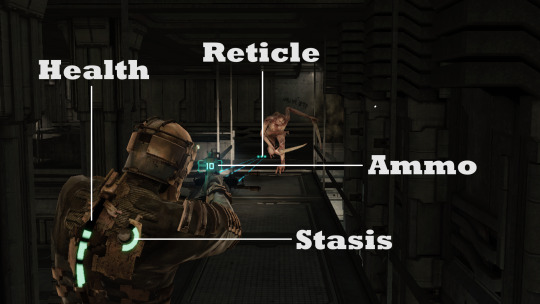
Dead Space has no HUD in the conventional sense. Instead, everything is made in a thematic and lore-consistent way - ammo is displayed where Isaac can see it, the reticle is in a position where Isaac would be able to use it, Health and Stasis would be visible to other nearby engineers. I'd like to use a similar method as Visceral Studios in displaying the information without a HUD, integrating it into the 3D environment.
Mirror's Edge
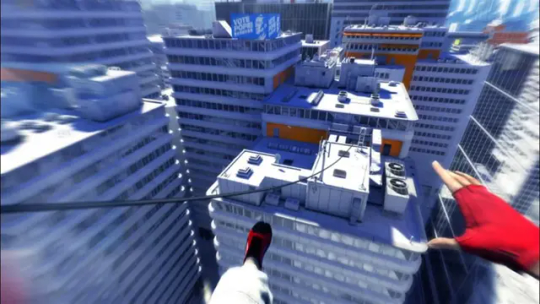
Mirror's Edge just... has no HUD. No information is displayed. Although this is a solid concept, my game uses a lot of luck and gambling which nescessitates communication of player and enemy health to the player. However, I could leave this more ambiguous, such as a light above each character that transitions from green to red depending on the repective health - either in increments or via a gradual gradient.
Metro Exodus

Games in the Metro series tend to use similar methods to the Dead Space HUD, with information being displayed on Artyom's wrists. However, due to Metro being first person, there is a lot less screen area to work with, so information that needs displaying requires rationing and prioritisation.
War Thunder and HOI4


The HUD of WT and HOI4 is cluttered. Despite WT being more tactical and HOI4 strategic, both have a considerable amount of information that need to displayed - for WT, ammo allocation, type, count, and ammo loaded and the entire economic, military and politcial status of a nation in HOI4. This is exactly what I want to avoid. Due to having little information needed to display, I should be able to avoid the information overload of HOI4 and WT.
Persona V

Persona uses a HUD with features that would be expected from most games of this type. However, it is heavily stylised with all HUD elements being appropriately coloured and designed. Although with a very different visual style, I intend to ensure my game is equally stylised, with all elements tied to the theme.
Engineering:
Nixie Tubes

Nixie Tubes are rather complicated and unfortunately, I am an idiot. However, I think they look beautiful. In theory, I could absolutely create a nixie tube display to display the player/enemy health - I might even be able to change the colour of the text from green to red. However, as much as I love this, it might not completely work with my environment.
Watch Hands

in theory, I could create a clock display above each player to represent their health. This would likely nescessitate setting default health as 60 [and tweaking damage], but it's definitely something I could do. As with the nixie tubes, this may not fit my theme as well as I'd like.
0 notes
Text
4e: The Were-With-All
Players love options. Players love the ability to differentiate their character. One of the problems that D&D character building has is that, certainly in the versions that are centralised like 3e, any given member of a class has a certain limited number of options that are worth taking. A wizard wouldn’t take Weapon Focus (Longsword), for example, even if the longsword is the best weapon of its type. This meant that there were a lot of options that were made to create or convey a mood about a character that weren’t worth spending one of your limited feat choices on.
In 4e, they added another dimension to each character, with the idea of character themes. Character themes were optional, and gave a character in the level range of 1-10 something class-independent that nonetheless let you expand the abilities of your character in a way that had a sort of, well, for lack of a better word, a vibe. By making these packages contained, it meant that the game mechanics for them could be balanced against one another —
Which unfortunately, they weren’t.
See, themes are a forgotten, excellent spicy component of the 4th edition character building. The classic D&D character building is race/class, where you know, you have an elf fighter, or an orc wizard, or whatever, and those player options are meant to represent broadly, all the things about your character that let you interface with the story. Earlier versions of the game meant that you might ask the DM for specific things that represent your character’s specific story, but in 3e there was a push towards ensuring that players never got that kind of tailoring, because it would disrupt the delicately balanced game system of 3e that relied on all players having access to equal
and commensurate
power
sorry, I couldn’t finish that joke.
Point is that themes were an addition after the fact and as good as they are at giving player characters an extra dimension, a lot of them were designed before a good solid power level for them had been properly dialed in. Basically, about ten of the themes are ‘the good ones’ and then the rest are ‘okay, but.’ There’s also two gross outliers – the Fey Beast Tamer and the Guardian. Still, there’s room for a lot of ‘okay’ under ‘too good,’ and in that space, the game system had room to slot the werewolf, werebear and wererat.
If you follow the How To Be series, you’ll know I recommend the werebear reasonably commonly, when I’m talking about a mode-shifter character. I like mode-shifting characters, after all, it stands to reason I’m going to use it. Thing is, I’d recommend it more if it was, uh, generally good.
The best thing about the werewolf, thematically, in heroic is that you can turn into a wolf. Cool! So can The Pack Outcast, and it doesn’t give up everything to do it, and when you fight, it also gives you combat advantage.
I recommend the werebear as a way to solve a problem, which is usually, a problem with the Knight. Knights make nothing but basic attacks. Werebears can make pretty good basic attacks. Knight features amplify their basic attacks, or trigger on their basic attacks. It’s not like the knight werebear is generally good, it’s just if you mode shift, and want to work as a defender, the knight werebear is one of your best use cases for either and it’s one of the simplest characters you can make and play. That’s the thing that recommends it – both knight and werebear shut you out of a lot of options.
These themes run into the problem that if you don’t need what they offer in terms of a shapeshifting combat form, you wouldn’t take them. They wouldn’t pull you towards making the character into this kind of thing without that demand, without the need to be werewolfy, or wereratty. Werewolves at level 10+ get pretty good, because then they can access beast form powers and keywords freely, in all forms, which means there’s finally a reason for a druid to want to be one, but that’s also solving a problem the druid doesn’t really have at level 10+.
The wererat is just kind of a sad orphan. You make a character with the wererat theme because you want to play a wererat, and that very specific, narrow flavour lines up – like, if you say ‘this character is a wererat’ it invokes a kind of rogue skillset right? Knifey, sneaky? The thing is, there are a lot of things rogues already do and the wererat doesn’t add anything to that. A melee basic attack that doesn’t use your own weapon and inflicts 1d4 damage and ongoing damage just isn’t going to be worth it almost all the time.
I like the lycanthropes a lot – they’re solid in the Paragon tier! But before that point, you kind of need very specific circumstances for them to work, and that strikes me as a problem. It’s part of a greater problem – that most of the themes are a little weak, or a little too specific. These types of shapeshifting animal monster people are fun. I think they’re fun and I want them to be good. I want them to work so that if you play a character who ‘should’ work with the claws and fangs and teeth side of things, it shouldn’t need you to jump through two dozen hoops to get there.
My ideal situation with themes is that a player should be able to look at a term that meaningfully relates to their character and go ‘oh, yeah, that! That’s cool!’ and pick it and get something that works. It’s okay for things to pull in different directions, but it’s not okay for a broad archetype term like werewolf to pull in only one direction and still rarely be worth it. I don’t like the idea that spending resources on cheap magical items should replace something that should be ‘how your character exists.’
Check it out on PRESS.exe to see it with images and links!
0 notes